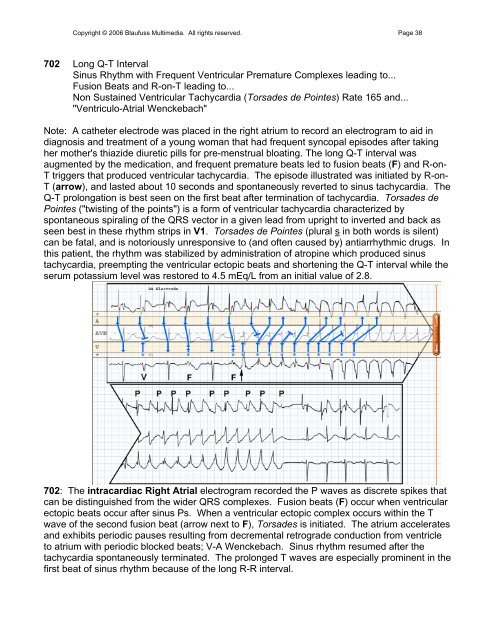002 Sinus Rhythm, atrial rate 90 Mobitz II - Blaufuss Multimedia
002 Sinus Rhythm, atrial rate 90 Mobitz II - Blaufuss Multimedia
002 Sinus Rhythm, atrial rate 90 Mobitz II - Blaufuss Multimedia
You also want an ePaper? Increase the reach of your titles
YUMPU automatically turns print PDFs into web optimized ePapers that Google loves.
Copyright © 2006 <strong>Blaufuss</strong> <strong>Multimedia</strong>. All rights reserved. Page 38<br />
702 Long Q-T Interval<br />
<strong>Sinus</strong> <strong>Rhythm</strong> with Frequent Ventricular Premature Complexes leading to...<br />
Fusion Beats and R-on-T leading to...<br />
Non Sustained Ventricular Tachycardia (Torsades de Pointes) Rate 165 and...<br />
"Ventriculo-Atrial Wenckebach"<br />
Note: A catheter electrode was placed in the right atrium to record an electrogram to aid in<br />
diagnosis and treatment of a young woman that had frequent syncopal episodes after taking<br />
her mother's thiazide diuretic pills for pre-menstrual bloating. The long Q-T interval was<br />
augmented by the medication, and frequent premature beats led to fusion beats (F) and R-on-<br />
T triggers that produced ventricular tachycardia. The episode illust<strong>rate</strong>d was initiated by R-on-<br />
T (arrow), and lasted about 10 seconds and spontaneously reverted to sinus tachycardia. The<br />
Q-T prolongation is best seen on the first beat after termination of tachycardia. Torsades de<br />
Pointes ("twisting of the points") is a form of ventricular tachycardia characterized by<br />
spontaneous spiraling of the QRS vector in a given lead from upright to inverted and back as<br />
seen best in these rhythm strips in V1. Torsades de Pointes (plural s in both words is silent)<br />
can be fatal, and is notoriously unresponsive to (and often caused by) antiarrhythmic drugs. In<br />
this patient, the rhythm was stabilized by administration of atropine which produced sinus<br />
tachycardia, preempting the ventricular ectopic beats and shortening the Q-T interval while the<br />
serum potassium level was restored to 4.5 mEq/L from an initial value of 2.8.<br />
702: The intracardiac Right Atrial electrogram recorded the P waves as discrete spikes that<br />
can be distinguished from the wider QRS complexes. Fusion beats (F) occur when ventricular<br />
ectopic beats occur after sinus Ps. When a ventricular ectopic complex occurs within the T<br />
wave of the second fusion beat (arrow next to F), Torsades is initiated. The atrium accele<strong>rate</strong>s<br />
and exhibits periodic pauses resulting from decremental retrograde conduction from ventricle<br />
to atrium with periodic blocked beats; V-A Wenckebach. <strong>Sinus</strong> rhythm resumed after the<br />
tachycardia spontaneously terminated. The prolonged T waves are especially prominent in the<br />
first beat of sinus rhythm because of the long R-R interval.


